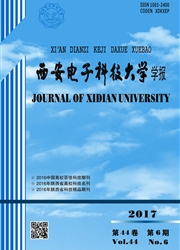

 中文摘要:
中文摘要:
针对异构网络并发传输时分流策略如何使系统性能最大化的问题,建立了分析异构多接入网络并发传输端到端时延的等效排队论模型,并由此模型获得了并发传输系统的理论时延界.在此基础上,提出了多接入网间资源联合调度的分流策略,包括最短等待时延分流策略和统一队列管理分流策略.在两异构网络并发传输系统中,通过二维马尔科夫链对最短等待时延分流策略和统一队列管理分流策略的时延性能进行了分析.仿真结果表明,这两种分流策略在保证最优吞吐量不变的前提下有效地降低了系统的平均时延,在高负载情况下可逼近理论时延界.同时,最短等待时延分流算法可显著地降低并发传输的时延抖动.
 英文摘要:
英文摘要:
We focus our attention on how to get optimal performance of concurrent transmission in heterogeneous networks. An equivalent queuing model is used to analyze the end-to-end delay performance of perfect splitting strategy with the theoretical delay bound found. Furthermore, two splitting algorithms, Minimum Queuing Delay based splitting strategy (MQD) and Unified Queuing Management Based Splitting Strategy (UQM), are presented based on the joint resources scheduled in different RATs (Radio Access Technology). In the two-RAT scenario, the two-dimensional discrete-state continuous-time Markov process is used to analyze our schemes with close-formed solutions found. Simulation results demonstrate that our proposed flow splitting strategies utilize the system resources efficiently and outperform current strategies, getting close to the theoretical delay bound especially in the heavy load region.
 同期刊论文项目
同期刊论文项目
 同项目期刊论文
同项目期刊论文
 Bandwidth-Aware High-Throughput Routing With Successive Interference Cancelation in Multihop Wireles
Bandwidth-Aware High-Throughput Routing With Successive Interference Cancelation in Multihop Wireles Energy Ef?ciency and Delay Tradeoff in Device-to-Device Communications Underlaying Cellular Networks
Energy Ef?ciency and Delay Tradeoff in Device-to-Device Communications Underlaying Cellular Networks Optimal Rate Allocation Based on Cross-Layer Design and End-to-End Congestion Control in WCDMA Netwo
Optimal Rate Allocation Based on Cross-Layer Design and End-to-End Congestion Control in WCDMA Netwo Joint spectrum-ef?cient routing and scheduling with successive interference cancellation in multihop
Joint spectrum-ef?cient routing and scheduling with successive interference cancellation in multihop Efficient Link Scheduling with Joint Power Control and Successive Interference Cancellation in Wirel
Efficient Link Scheduling with Joint Power Control and Successive Interference Cancellation in Wirel End-to-End Delay Distribution Analysis for Stochastic Admission Control in Multi-hop Wireless Networ
End-to-End Delay Distribution Analysis for Stochastic Admission Control in Multi-hop Wireless Networ 期刊信息
期刊信息
